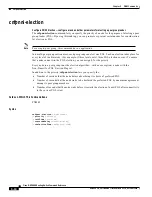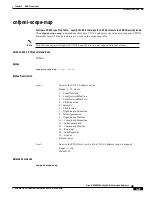
5-29
Cisco MGX 8850 Routing Switch Command Reference
Release 2.0, Part Number 78-10467-04 Rev C0, October 2001
Chapter 5
PNNI Commands
cnfpnni-node
-nodeId
Specify the PNNI node identifier assigned to a PNNI node. The node-id
consists of the PNNI hierarchy level (-level) followed by the length of the
ATM address (addaddr length) followed by the ATM address (-atmAddr).
Note
Before you change the node ID, you must first use the
cnfpnni-node command one time with the parameter string
-enable false to disable the node. After changing the node ID,
run the command with the parameter string -enable true.
As shown in
Figure 5-6
, -nodeId is a 22-byte, formatted hexadecimal string.
Like all PNNI addresses, identifiers, and prefixes, this value is portrayed as
a string of hexadecimal “nibbles.” One or several pairs of nibbles entail each
parameter field.
Default:
Figure 5-6
shows the factory-set default.
-pgId
All members of a peer group have the same peer group identifier (pgID) and
exist on the same level. (The level is either the existing number of bits or
whatever you specify with -level level).
The default value of level is 56 (7 bytes), which specifies the length of -pgId
to 7 bytes. However, the maximum length of -pgId is 14 bytes, so display
commands always show -pgId as 14 bytes with trailing zeros filling the
undefined fields. If you increase the value of level, you change the length,
and therefore the value, of -pgId, but it will always be displayed as 14 bytes.
Before you change the value of pg-id, disable the node by entering
cnfpnni-node -enable false.
This is a 14-byte, formatted hexadecimal string.
Default:
Figure 5-6
shows the factory-set default.
-enable
Specify the administrative status of the PNNI node. Before you change a
node ATM address, node ID, peer group ID, or hierarchical level, the node
must be disabled.
true: Enable the node.
false: Disable the node.
Default: true
-transitRestricted
Specify whether connections can transit this node. You can disallow via
connections for security reasons, to minimize traffic supported by either a
low bandwidth node or a highly critical node, and so on.
on: This node allows via connections.
off: Via connections cannot transit this node.
Default: off
















































